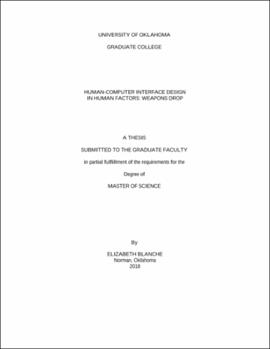| dc.contributor.advisor | Kang, Ziho | |
| dc.contributor.author | Blanche, Elizabeth | |
| dc.date.accessioned | 2018-12-14T14:58:02Z | |
| dc.date.available | 2018-12-14T14:58:02Z | |
| dc.date.issued | 2018-12-14 | |
| dc.identifier.uri | https://hdl.handle.net/11244/316770 | |
| dc.description.abstract | In a technologically advanced world, aircraft users tend to get caught up in all of the automation. However, if the automated function stops working, the users are left with analog skills to meet their mission. For the B-1, this means the users must be able to multitask and be proficient in both digital and analog. It is important to design an interface in which the users can be competent and limit the amount of human error in the process. This experiment was performed to see which interface design the users best performed at with the least amount of human error in weapons selection. The interfaces changed between and rotary based design and list based design. Each design also consisted of 2 mission types, easy and hard. The difficulty was determined by the types of errors that could occur that were exterior to the users themselves. The results showed that for time, workload was not significantly impacted based on mission difficulty and interface type. The error results showed that workload was significantly impacted based on mission difficulty and interface type. The users were also clear that the rotary based design was much more intuitive than the list based design. | en_US |
| dc.language | en_US | en_US |
| dc.subject | Interface Design | en_US |
| dc.subject | Human Factors | en_US |
| dc.subject | Weapons | en_US |
| dc.subject | Human Error | en_US |
| dc.title | Human-Computer Interface Design in Human Factors: Weapons Drop | en_US |
| dc.contributor.committeeMember | Shehab, Randa | |
| dc.contributor.committeeMember | Raman, Shivakumar | |
| dc.date.manuscript | 2018-11-27 | |
| dc.thesis.degree | Master of Science | en_US |
| ou.group | Gallogly College of Engineering::School of Industrial and Systems Engineering | en_US |
